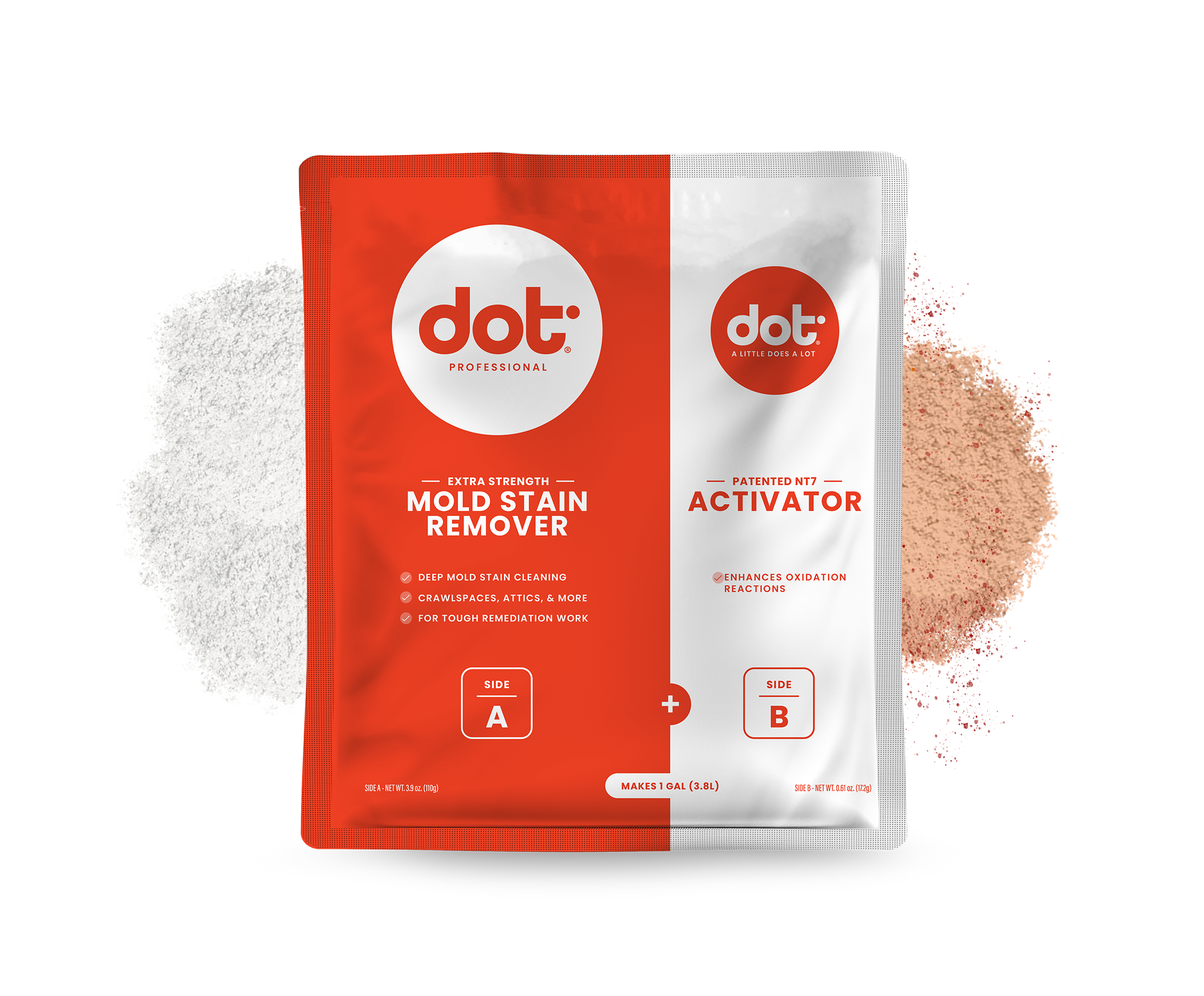How to REMOVE Mold Stains from Attics
Introduction
The primary objective in cleaning any attic is to remove soiling, mold structures and colonies, staining, and other contaminants from decking. Often times, a scope of work may include HEPA vacuuming, insulation removal, or other steps.
Dot Cleaner can be used to effectively remove surface staining and help clean heavy contamination from decking materials with less chemical and less odor. Follow the simple steps below to transform any attic and impress any inspector, homeowner, or property manager.
Getting started
-
If insulation is to be removed, we recommend cleaning be done first to allow insulation materials to absorb falling cleaning product (dripping) and to avoid staining and discoloration of underlying drywall or other ceiling materials. In many cases where deck staining is a concern for resale, surface cleaning alone may be enough to resolve concerns and present the area acceptable to lenders, inspectors, or homeowners. Insulation, in general, contains a large quantity of mold spores. Even if it is replaced as part of the remediation work, it will quickly retain ambient mold spores due to air movement through the materials and dust particulate settling.
-
Scissors/Knife
Power Drill + Paint Mixer
Mixing Bucket
Preferred Spraying Equipment (Powered Systems Recommended for Tougher Jobs)
Long Handled Scrub Brush/Deck Broom
Rags and Microfiber Towels,
Trash bag(s)
PPE
-
Dot is designed to remove mold and other organic stains through oxidation. There are other types of stains you may find on wood that will not be removed by Dot or any oxidation methods. These stains include:
Water staining/marking in wood
Rust and/or iron oxide in wood. Iron oxide reacts with tannins in wood materials to form dark black staining that flows from nails or metal components.
Inks, dyes, or grease staining
-
All confined space work should be done with two people and workers should wear appropriate PPE for the space and job.
Remove any debris or items in the attic space. Items that are stored and will remain may be covered with plastic sheeting prior to treatment to prevent damage.
Disengage electrical lines at the power box if exposed wires (not in casing) are present in the space prior to treatment.
You should plan to use approximately 1 gallon of mixed product per 200 square feet of attic floor space. Attics vary in height and complexity, so more product may be required for your particular job. Dot Extra Strength Mold Stain Remover is recommended for this application. For lighter staining, Dot Mold & Mildew Stain Surface Cleaner may also be used. Make approximately ½ of needed product prior to start of cleaning.
We find Dot works well in any spraying system, including powered (pump) systems. We recommend the use of pressurized systems to deliver higher product flow more consistently. Ideally, your sprayer should sit outside of the space to be cleaned and have a delivery hose that is 75-100 feet long. For attic cleaning, delivery between 70-90 psi is recommended. This provides easier movement throughout the attic and dramatically lowers both time required and the fatigue of workers.
-
Dot® pouches are split into two sides: Side A contains an Oxidizer, and Side B contains our patented Activator. When our patented Activators are mixed with the oxidant, Dilute Oxidation Technology is engaged, resulting in powerful cleaning with dramatically less chemical.
Fill mixing container with 1 gallon of water for every gallon of Dot you need. For best results, use hottest available water.
Pour Side A contents of all pouches into the water. Stir powder vigorously until fully dissolved. For best results, use a power drill with a paint mixer attachment.
Pour Side B contents of all pouches into mixed solution. Stir vigorously until fully dissolved.
Pour Dot Cleaner into your preferred spraying equipment. Powered Systems are recommended for tough jobs.
HOW TO APPLY DOT CLEANER TO Attic Surfaces
STEP 1
Start at entry to attic space and spray surfaces from soffit to peak, first on one side, then the other (turn around). Avoid spraying directly overhead when possible. Only try to cover 2-3 bays (space between rafters) at one time. This helps keep track of where you are at. Move towards furthest point from entrance.
STEP 2
Brush surfaces that are heavily soiled or stained to break up surface contamination. Heavy scrubbing is not needed in most cases, as most attics respond well with spraying alone. We recommend using a rounded soft bristle brush.
If brushing was needed, reapply Dot Cleaner before moving on. This serves to rinse away debris onto the floor of the space as well as provide additional oxidation of contaminants.
STEP 3
Once you have moved from the entry to furthest point, slowly move back through the space reapplying Dot as needed for remaining staining. Dot may be applied multiple times to the same surface when heavy stains are present. Reapplication will accelerate stain removal performance.
STEP 4
Wipe down drips or overspray as needed with microfiber towel. Some attics may have air handlers installed. Wipe these down with microfiber towels as well before completion.
STEP 5
If insulation is to be removed as part of your remediation plan, remove insulation.
STEP 6
After cleaning, HEPA vacuum space as your plan requires. We recommend HEPA vacuuming after stain removal in most cases. However, HEPA vacuuming prior to cleaning could be used to remove heavy contamination in some cases.
Finishing up
Allow attic to dry normally. While Dot Cleaner is highly effective at stain removal and most spaces will see a notable change in minutes, its unique chemistry allows stain removal to continue for hours or even days (usually 24hrs). Staining, color and overall look of the space will continue to improve while drying occurs.
OR
You can actively dry the attic space as part of a comprehensive drying plan. Clean the attic for mold growth before drying for best results/performance.
You can also immediately apply most preventative treatments to treated lumber once dripping has stopped.
EXTRA STRENGTH MOLD STAIN REMOVER
FEATURED PRODUCT
GET TECHNICAL HELP
With 20+ years of mold remediation experience, our Technical Support Lead Brian Lester provides 1-on-1 customer education and helps guide first-time Dot users.



